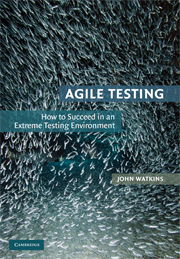Book contents
- Frontmatter
- Contents
- Foreword by Bob Bartlett
- Acknowledgments
- 1 Introduction
- PART 1 REVIEW OF OLD-SCHOOL AND AGILE APPROACHES
- PART 2 EVERYONE IS DIFFERENT: AGILE CASE STUDIES
- PART 3 AGILE MY WAY: A PROPOSAL FOR YOUR OWN AGILE TEST PROCESS
- APPENDIX A The Principles of Rapid Application Development
- APPENDIX B The Rules and Practices of Extreme Programming
- Appendix C The Principles of the Dynamic Systems Development Method
- Appendix D The Practices of Scrum
- APPENDIX E Agile Test Script Template
- Appendix F Agile Test Result Record Form Template
- Appendix G Agile Test Summary Report Template
- Appendix H My Agile Process Checklist
- References
- Index
PART 3 - AGILE MY WAY: A PROPOSAL FOR YOUR OWN AGILE TEST PROCESS
Published online by Cambridge University Press: 26 October 2009
- Frontmatter
- Contents
- Foreword by Bob Bartlett
- Acknowledgments
- 1 Introduction
- PART 1 REVIEW OF OLD-SCHOOL AND AGILE APPROACHES
- PART 2 EVERYONE IS DIFFERENT: AGILE CASE STUDIES
- PART 3 AGILE MY WAY: A PROPOSAL FOR YOUR OWN AGILE TEST PROCESS
- APPENDIX A The Principles of Rapid Application Development
- APPENDIX B The Rules and Practices of Extreme Programming
- Appendix C The Principles of the Dynamic Systems Development Method
- Appendix D The Practices of Scrum
- APPENDIX E Agile Test Script Template
- Appendix F Agile Test Result Record Form Template
- Appendix G Agile Test Summary Report Template
- Appendix H My Agile Process Checklist
- References
- Index
Summary
A very important lesson to be learnt is that there is always another lesson to be learnt; the goal of fine-tuning our processes continues today, and will continue into the future.
Tom GilbThis section of the book provides an analysis of the agile case studies presented in Part 2 and draws upon the material from Part 1 to make a series of proposals about what components might be used to generate your own successful agile testing approach:
Chapter 24, Analysis of the Case Studies, examines in detail the agile case studies presented in Part 2, identifying particularly successful agile techniques, common themes (such as successful reusable templates), as well as those testing approaches that were not successful and which may need to be treated with caution.
Chapter 25, My Agile Process, draws on the information covered in the earlier chapters of this book and on the information provided in the case studies and their analyses to make a series of proposals for how you might set up and run your own practical, effective, and efficient agile testing process.
Chapter 26, The Roll-out and Adoption of My Agile Process, provides advice and guidance on how to successfully introduce, roll out, and drive the use and adoption of your agile process within your own organization.
- Type
- Chapter
- Information
- Agile TestingHow to Succeed in an Extreme Testing Environment, pp. 191 - 192Publisher: Cambridge University PressPrint publication year: 2009



